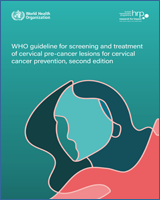The Department of Sexual and Reproductive Health and Research and the Department of Global HIV, Hepatitis and Sexually Transmitted Infections Programmes at the World Health Organization (WHO) would like to thank members of the Guideline Development Group (GDG) for their consistent availability and commitment to making this guideline possible, and the members of the External Review Group (ERG) and all other external contributors for their work. The Departments are also grateful to the International Agency for Research on Cancer (IARC) for the literature reviews performed in the context of the updating of the IARC handbooks of cancer prevention: cervical cancer screening, Vol. 18 (2021), which were extremely useful for this guideline development process. Special thanks to Nancy Santesso, the guideline methodologist from McMaster University, who also led the systematic review process, and thank you to all the members of the systematic reviews teams, coordinated by Nancy Santesso. The names of the members of the GDG, ERG and of the other contributors, in particular systematic reviewers, modellers and costing teams, are listed below, with full details provided in Annex 1. We appreciate the overall support of the WHO Guidelines Review Committee Secretariat during the guideline development process, with grateful thanks to Rebekah Thomas Bosco who is leading the GRC Secretariat.
The WHO Steering Group was composed of Nathalie Broutet, Shona Dalal, Linda Eckert (who also supported the GDG, the workgroups, and the WHO Secretariat), Morkor Newman and Ajay Rangaraj. This group was assisted by Myriam Cortes and Jane Werunga-Ndanareh. Nathalie Broutet and Shona Dalal also led the guideline development process.
The members of the GDG were Claire Achieng, Silvina Arrossi, Muhammad Atif Waqar, Ruth Awori, Ruanne Barnabas, Itamar Bento Claro, Neerja Bhatla, Marie-Claude Boily, Laia Bruni, Joanna Cain, Lameck Chinula, Mike Chirenje (GDG Co-Chair), Michael Chung, Flavia Miranda Correa, Miriam Cremer, Teresa Darragh, Lynette Denny, Silvia de Sanjose, Mamadou Diop, Wachara Eamratsameekool, Danielle Engel, Julia Gage, Ali Ghanbari-Motlagh, Patti Gravitt, Margaret Happy, Tarek Hashem, Rolando Herrero, Priscilla Ingbian, Ebony Johnson, Sharon Kapambwe, Bayarsaikhan Luvsandorj, Anne Mackie, Mauricio Maza, Sebitloane Motshedisi, Nelly Mugo, Raul Murillo, Laura Muzingwani, Ashrafun Nessa, Dorcas Obiri-Yeboah, Gina Ogilvie, Patrick Petignat, Maria Alejandra Picconi, Leeya Pinder, Walter Prendiville, Veronica Reis, Gracia Violetta Ross Quiroga, Vikrant Sahasrabuddhe, Pete Sasieni, Anna Shakarishvili, Netsanet Shiferaw, Petra Tenhoope-Bender, Myint Myint Thinn, Julie Torode (GDG Co-Chair), Nicolas Wentzensen and Fanghui Zhao.
The members of the ERG were Raveena Chowdhury, Heather Cubie, Suzanne Garland, Sarita Ghimire, Zaki El Hanchi, Ha Hyeong In, Oh Jin-Kyoung, Alejandra Meglioli, Mohammed Moawia, Lim Myong Cheol, Angélica Nogueira, Mark Schiffman, Saritha Shamsunder, Vanita Suri, Carolina Teran, Ted Trimble, Gino Venegas and Heather White.
External contributors to the evidence profiles were Marc Arbyn, Ruanne Barnabas, Iacopo Baussano, Marie-Claude Boily, Veronique Bouvard, Karen Canfell, Michael Caruana, Ian Cree, Owen Demke, Cindy Gauvreau, Michaela Hall, Eva Herweijer, Iciar Indave, Adam Keane, Helen Kelly, James Killen, Gigi Lui, Diep Nguyen, Bernardo Nuche, Catherine Sauvaget, Holger Schünemann, Kate Simms, Ronaldo Silva, Karin Sundström, Katayoun Thaghavi, Cari van Schalkwyk and Brian Williams.
The following individuals acted as observers at the GDG meeting: Benjamin Anderson, J. (Hans) Berkhof, Smiljka de Lussigny, Eduardo Franco, Lisa Pei-Ching Huang, Krishna Jafa, Jose Jeronimo, Somesh Kumar, Ilana Lapidos-Salaiz, David Mesher, Jasantha Odayar, Groesbeck Parham, Carmen Pérez Casas, Felipe Roitberg and Heather Watts.
The WHO Secretariat included Maribel Almonte Pacheco, Prebo Barango, Partha Basu, Paul Bloem, Nathalie Broutet, Gary Clifford, Marilys Corbex, Myriam Cortes, Shona Dalal, Jean-Marie Dangou, Maeve De Mello, Gampo Dorji, Linda Eckert, Fayad El Sheikh, Elena Fidarova, Massimo Ghidinelli, Karima Gholbzouri, Rodolfo Gomez Ponce de Leon, Sami Gottlieb, Joumana George Hermez, Raymond Hutubessy, Andre Ilbawi, Naoko Ishikawa, Chandani Anoma Jayathilaka, Rajat Khosla, Warrick Junsuk Kim, Stephanie Yetunde Kuku, Hugues Lago, Beatrice Lauby-Secretan, Silvana Luciani, Priya Mannava, Dara Masoud, Manjulaa Narasimhan, Morkor Newman, Leopold Ouedraogo, Tina Purnat, Neena Raina, Ajay Rangaraj, Leanne Margaret Riley, Anita Sands, Tshidi Sebitloane, Mukta Sharma, Hai-rim Shin, Slim Slama, Vitaly Smelov, Howard Sobel, Ute Ströher, Adriana Velazquez Berumen, Lara Vojnov and Hongyi Xu.
Funding for the preparation, development and printing of the guideline was provided mainly by the UNDP-UNFPA-UNICEF-WHO-World Bank Special Programme of Research, Development and Research Training in Human Reproduction (HRP), with the support of the United States President’s Emergency Plan for AIDS Relief (PEPFAR) through the United States Agency for International Development (USAID), and Unitaid.
This guideline was edited and proofread by Green Ink.

